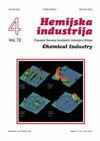Preparation of TGF-beta1/affinity-bound alginate macroporous scaffolds
IF 0.8
4区 工程技术
Q4 ENGINEERING, CHEMICAL
引用次数: 1
Abstract
Spatio-temporal presentation of growth factors is one of the key attributes of the cell's microenvironment. The design of macroporous alginate scaffolds, wherein TGF-b1 or BMP-4 is electrostatically bound to affinity binding sites of alginate sulfate, mimicking their presentation by the extracellular matrix (ECM), was previously shown to enable sustained presentation and release of each factor, thus increasing their biological activity. Specifically, TGF-b1/affinity-bound scaffolds induced the chondrogenic differentiation of human mesenchymal stem cells (hMSCs) seeded within these scaffolds. The prolonged activity of the affinity-bound TGF-b1 enabled efficient induction of signaling pathways leading to chondrogenesis, up to the appearance of committed chondrocytes. Similarly, BMP-4 affinity-bound to the macroporous alginate scaffold enabled efficient induction of osteogenic differentiation in hMSC constructs. Subsequent construction of a multicompartment inductive system, spatially-presenting TGF-b1 and BMP-4 in two distinct layers, enabled complete differentiation of hMSC to chondrocytes and osteoblasts, depending on the type of factor in use in the respective layer. This paper describes in detail the preparation method of the TGF-b1 or BMP4/ affinity-bound alginate scaffolds, and the set of analyses performed to characterize the resultant scaffolds, including release profile study, released factor bioactivity, and functionality of the scaffolds as hMSC-inductive scaffolds.TGF-β1/亲和结合藻酸盐大孔支架的制备
生长因子的时空呈现是细胞微环境的关键属性之一。大孔藻酸盐支架的设计,其中TGF-b1或BMP-4被静电结合到海藻酸盐的亲和结合位点,模拟它们通过细胞外基质(ECM)的呈现,先前已被证明能够持续呈现和释放每种因子,从而提高它们的生物活性。具体来说,TGF-b1/亲和结合支架可诱导植入这些支架内的人间充质干细胞(hMSCs)的软骨分化。亲和结合的TGF-b1活性的延长能够有效地诱导导致软骨形成的信号通路,直至形成固定的软骨细胞。类似地,BMP-4与大孔海藻酸盐支架的亲和力能够有效地诱导hMSC构建物的成骨分化。随后构建了一个多室诱导系统,将TGF-b1和BMP-4在两个不同的层中空间呈现,使hMSC完全分化为软骨细胞和成骨细胞,这取决于各自层中使用的因子类型。本文详细介绍了TGF-b1或BMP4/亲和结合海藻酸盐支架的制备方法,以及对所制备支架进行的一系列表征分析,包括释放谱研究、释放因子生物活性和支架作为hmsc诱导支架的功能。
本文章由计算机程序翻译,如有差异,请以英文原文为准。
求助全文
约1分钟内获得全文
求助全文
来源期刊

Hemijska Industrija
工程技术-工程:化工
CiteScore
1.60
自引率
11.10%
发文量
12
审稿时长
6-12 weeks
期刊介绍:
The Journal Hemijska industrija (abbreviation Hem. Ind.) is publishing papers in the field of Chemical Engineering (Transport phenomena; Process Modeling, Simulation and Optimization; Thermodynamics; Separation Processes; Reactor Engineering; Electrochemical Engineering; Petrochemical Engineering), Biochemical Engineering (Bioreactors; Protein Engineering; Kinetics of Bioprocesses), Engineering of Materials (Polymers; Metal materials; Non-metal materials; Biomaterials), Environmental Engineeringand Applied Chemistry. The journal is published bimonthly by the Association of Chemical Engineers of Serbia (a member of EFCE - European Federation of Chemical Engineering). In addition to professional articles of importance to industry, scientific research papers are published, not only from our country but from all over the world. It also contains topics such as business news, science and technology news, information on new apparatus and equipment, and articles on environmental protection.
 求助内容:
求助内容: 应助结果提醒方式:
应助结果提醒方式:


